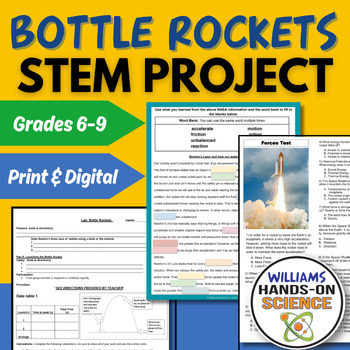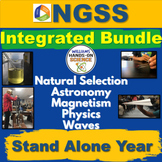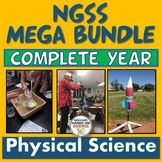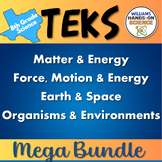End of Year STEM Project Forces Motion Newtons Laws Assessment Bottle Rockets
- Zip
What educators are saying
Also included in
- Your students will remember these activities forever! These are student centered, challenging, hands-on, engaging activities that will wow and motivate even some of the most reluctant learners. I also include an editable unit test and a modified Special Education/English Language Learner test. I’vePrice $59.97Original Price $88.75Save $28.78
- Looking for a complete, standalone year-long curriculum for integrated NGSS Physics, Energy, Waves, Astronomy, Earth’s History, Science and Engineering Practices, Crosscutting Concepts, and Evolution? Look no further than this student-centered, inquiry-based, hands-on bundle! Designed to align withPrice $205.00Original Price $366.00Save $161.00
- This bundle is a time-saving, comprehensive and user-friendly complete year bundle for physical science Teachers that will streamline your teaching experience effortlessly! Every lesson is meticulously planned and just a click away. This extraordinary bundle is a treasure trove of engaging resourcesPrice $176.00Original Price $311.50Save $135.50
- The TEKS 8th Grade Bundle is a comprehensive resource for teaching science mainly in Texas, but it can be used in any state. This bundle includes over 60 hands-on, rigorous, engaging, and phenomena-driven lessons that cover the TEKS standards for 8th grade science. The lessons are designed to help sPrice $160.00Original Price $321.15Save $161.15
Description
This product is one of the most engaging and meaningful activities I do all year long! What kid wouldn’t want to build and launch rockets!?! Just take a look at an email I received from a former student about her memories of the bottle rocket lab and how it changed her life:
Hi Mr. Williams,
“How is Oak Crest lately?
I was in your physical science class a loooooong long time ago (2008) and I thought I'd let you know that your bottle rockets project was what first got me into space propulsion. It was my favorite project in middle school by far, and I hope you're still doing it.
One thing led to another and now I'm a sophomore at Caltech studying applied physics, and I'm going to do research on micropropulsion systems at JPL for the summer. I think I even wrote about the bottle rockets on some college applications or something...
Thanks for everything!”
- If you'd rather use air rockets than bottle rockets, take a look at my Newtons Laws Forces and Motion STEM Air Rockets Project MS-PS2-1 as an alternative.
- This product can be two days to two weeks it’s up to you. You get very detailed teacher directions and diagrams of how to build the rockets. I provide a timeline of what we do on each day. 21 slide PowerPoint on the physics of rockets and a graphic organizer the students fill in as you lecture from the PowerPoint. I provide some NASA literature and fill in the blank/close reading that accompanies it. A student hand out and key and a modified version for your SPED/ELL population! AND it's in print and digital!
Click here and save over 40% by buying Forces and Energy
Bundle that has all my forces and energy resources.
The following concepts are included:
-Principals of rocketry
-Engineering
-Newton’s Laws
-Kinetic & Potential Energy
-Math
-Velocity
-Friction
-Momentum
-Gravity
Materials: You will need a rocket launcher and a bicycle pump. I use Pitsco launchers, but there are many different types online and you can even make your own. I have the students bring in one manila folder, 1 roll of duct tape, clay, 1-2 empty 2-liter soda bottles, old CD’s and any decorations that they choose. It’s helpful to be able to weigh/mass the rockets for optimal mass.
Day one-50 minutes: I have the students fill in the Vocabulary Chart/Graphic organizer that goes with the PowerPoint as I lecture. However you can use the NASA literature as scaffolding before this day or to reinforce later for homework. After they are done filling in the graphic organizers, we then look at slide #15 on the PowerPoint so the students can get in groups and decide who will bring in what materials. There is a chart the students can fill out on the last page of the Student Lab Handout for that.
Day two-1 hour 45 minutes: I model how to build the rockets using the Bottle Rocket Directions. We discuss “Part 1: Constructing Your Rocket” and I put the picture of my white board directions on the screen. I then give them the rest of the block period to build their rockets.
Day three-1 hour 45 minutes: We go over “Part II: Launching the Bottle Rocket”. We talk about safety by emphasizing they stay in the designated area that you deem safe and that the students pay attention to every launch. Rockets can stray because of poor design and/or wind. Students use their phones to film the launches and then when they return to class they can use the video to enter accurate times in their data tables. With that data, the students can calculate the distance and the velocity of their rockets. The formula I use is one of many and what I think is grade level appropriate for middle school and it’s the same equation the Homer Hickam played by Jake Gyllenhaal in the movie “October Sky”! I show this movie after we are done. There more accurate equations and methods out there, but for my student population they aren’t appropriate. If you’re using this for high school physics I’d recommend those. If you want to avoid the math all together, you can purchase an altitude finder or make one.
Day four-50 minutes: I usually give students time in class to work on the calculations and the questions, because they usually need help.
Day 5 and 6 (optional): If you want to add an engineering component, I have the “Bottle Rocket Iteration” handout. I have my students redesign new rockets and try to beat their first rocket’s altitude. I give them the same amount of time to build and launch as their first rockets. This would make this product more aligned to the NGSS standards. I know you may be thinking that two weeks is a long time, but that’s the direction of the NGSS standards and most of all, the kids learn so much and love it!!!
You get the following:
-Detailed teacher directions and support
-Student Handout in print and digital
-EL/SPED version in print and digital
-Answer Keys
-21 Slide PowerPoint on the science of rockets and how Newton's Laws apply
-Vocabulary Chart in print and digital
-NASA Close Reading and Notes in print and digital
-Assessment in print and digital
Please take a moment to subscribe to my blog at williamshandsonscience.comand get my latest freebies!
TERMS OF USE
• All rights reserved by Williams Hands On Science, Inc.
• This product is to be used by the original purchaser only.
• Intended for classroom and personal use only.
• Copying for more than one teacher, classroom, department, school, or school system is prohibited.
• This product may not be distributed or displayed digitally for public view.
• Failure to comply is a copyright infringement and a violation of the Digital Millennium Copyright Act (DMCA).
If there are any errors or questions, please contact me through TpT or email me at:
williamshandsonscience@gmail.com
Thanks for purchasing this product and please email me with any questions:
williamshandsonscience@gmail.com
Take a look at my bundles
Physical Science Growing Bundle
Integrated NGSS Middle School Science MEGA Bundle Full Year
Integrated Forces & Energy Bundle NGSS MS-PS2-1 & 2 MS-PS3 4 & 5 PS2.A PS2.B
Related Products
⭐ 10 Editable Motion Bell Ringer Warm Ups and Key
⭐ 5E NGSS Collision Lab: Relationship between Motion and Forces
⭐ Balloon Rockets Lab
⭐ Bell Ringer Warm Up: Force, Acceleration, Graphing & Energy
⭐ Bell Ringer Warm Up: Force, Acceleration, Graphing & Energy
⭐ Bell Ringer Warm Up: Speed, Acceleration & Graphing
⭐ Bell Ringer Warm Up: Speed, Acceleration & Graphing
⭐ Bell Ringer Warm Up: Speed, Acceleration & Graphing
⭐ FORCES: 50 Editable PowerPoint Slides with Hyperlinks
⭐ Forces Warm Up
⭐ Middle School Physics Motion PowerPoint, Guided Notes, Study Guide & Test
⭐ Middle School Physics Bell Ringers (Warm Ups)
⭐ NGSS Flipping the Classroom with Frayer Forces and Interactions
⭐ NGSS Kinetic and Potential Energy Card sort, Energy Worksheet & Close Reading
⭐ NGSS Middle School Chemistry Bundle
⭐ NGSS Middle School Physics Bundle & ASSESSMENT
⭐ NGSS Newton's Laws Card Sort & 50 Slide PowerPoint
⭐ NGSS Physics Speed, Time and Distance Math Problems
⭐ NGSS STEM 5E Paper Airplane Competition Engineering Design Process
⭐ NGSS Special Education & ELL Graphing Motion Worksheets
⭐ NGSS Speed, Time, Distance, Acceleration and Graphing Worksheets
⭐ Netwon's Laws Drawing Review: Winter Holidays
⭐ Newton's Laws Physics Problems
⭐ Newton's Laws Test and Study Guide (Editable)
⭐ PhET Simulation: Moving Man Graphing Motion Online Lab
⭐ Physics Online Computer Simulation Lab
⭐ Roller Coaster Energy Warm Up
⭐ STEM 5E NGSS Aligned Balloon Cars Lab Engineering Design Process
⭐ STEM Bottle Rockets Lab PowerPoint Graphic Organizers Close Reading Cloze Notes
⭐ STEM NGSS Middle School Science Growing MEGA Bundle
⭐ STEM NGSS Physics Resource Bundle
⭐ STEM Roller Coaster Lab & Card Sort Engineering Design Process









